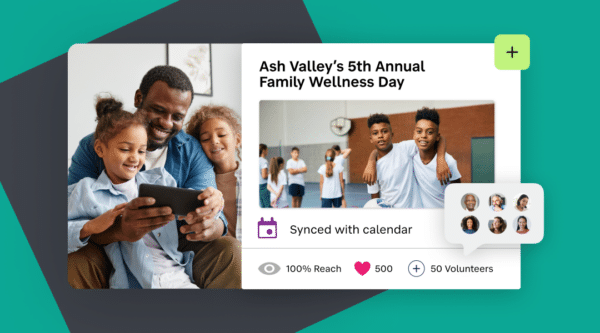

As the school year winds down, educators have one final opportunity to strengthen the connection between schools and families. The last few weeks of school are often packed with events, testing, report cards, and planning for the next year. Amid the busyness, it is easy for communication to become routine or transactional. But this time of year presents a unique moment to build meaningful relationships that will carry into the next school year.
Family engagement is not only about checking boxes or sending reminders. It is about creating consistent, two-way communication that helps families feel involved, informed, and confident about their child’s educational experience. When parents are engaged, students are more likely to attend school, stay motivated, and succeed in the classroom. With just a few weeks left in the academic year, districts and schools can still make a lasting impact.
Here are three proven ways to increase family engagement before summer begins.
1. Personalize Parent Communication to Make Every Message Count
This time of year, families are flooded with emails, paper flyers, texts, and announcements. From graduation information to summer program sign-ups, the sheer volume of communication can be overwhelming. The key to getting through the noise is personalization.
When messages are tailored to each family’s needs and student data, they are more likely to be opened, read, and acted on. That doesn’t mean every message must be written from scratch. But it does mean using a platform that gives educators the ability to send targeted, relevant updates based on real-time information.
For example, instead of sending a general reminder about attendance policies, a teacher might send a quick note to a parent whose student has improved attendance in the last month. That message could reinforce the progress and encourage continued support through the final weeks of school.
Administrators might send end-of-year updates that include a personalized summary of a student’s growth or behavior highlights. When families receive messages that reflect what is actually happening with their child, engagement becomes more meaningful.
Here are a few ways to personalize communication effectively:
- Use student names and grade-specific information
- Reference recent achievements or upcoming milestones
- Offer multiple language options to ensure accessibility
- Allow families to reply and ask questions directly
Platforms like SchoolStatus Connect make it easy for teachers and staff to send individualized messages at scale, while still managing compliance and consistency across the district. With built-in translation, delivery tracking, and messaging analytics, schools can communicate with every family in a way that is clear and impactful.
Want to go deeper?
Download our eBook: The Connected District: Building K-12 Community Engagement
Further reading:
The Dual Capacity-Building Framework for Family-School Partnerships via the U.S. Department of Education
2. Highlight Student Growth and Non-Academic Wins
Grades and test scores matter, but they do not tell the full story of a student’s year. Many families are equally interested in how their children are growing in character, behavior, effort, and participation. Recognizing and sharing these wins not only boosts student confidence but also helps families feel more connected to the school community.
As the year ends, consider expanding your communication beyond academic updates. Celebrate the ways students have shown leadership, resilience, creativity, or kindness. Even a simple note recognizing a student for being a positive influence in class can go a long way.
When schools celebrate these moments, families feel proud and included. Students feel seen. And the school culture becomes one that values the whole child, not just performance on a test.
Here are some ways to communicate student growth:
- Create “year in review” emails that include student highlights and photos. (Tip: Send it in an easy-to-use Smore newsletter)
- Host student-led conferences to reflect on personal goals and progress
- Share weekly or monthly shoutouts that include behavioral, attendance, or social-emotional growth
- Encourage teachers to send quick texts or emails recognizing individual progress
The goal is to show families that the school sees and values their child’s efforts, no matter where they started or how much they have improved.
Explore more insights in our 2024-25 Mid-Year Attendance Snapshot for PK-12 Students
Supporting research:
Harvard Family Research Project on Family Engagement
3. Streamline Family Outreach with Clear, Actionable Messages
By the end of the school year, parents are trying to manage work, family schedules, and school logistics all at once. When schools send messages that are long, unclear, or scattered across platforms, families may miss critical information or become disengaged. That is why simplifying family outreach is one of the most effective strategies for improving parent involvement before summer break.
Clear, consistent communication helps families take action. Whether it is submitting forms, confirming event attendance, or preparing for summer learning, families are more likely to follow through when expectations are easy to understand and instructions are easy to follow.
Here are a few best practices to streamline outreach:
- Use a single platform for messaging across schools and departments
- Avoid sending the same message multiple times across different channels
- Keep calls to action simple and prominent
- Provide translation and formatting options to support the needs of every family
For example, if your school is sending information about a graduation ceremony, include the event details, parking instructions, dress code, and RSVP link all in one place. Make sure the message is mobile-friendly and provides a contact point for questions.
When messages are focused and easy to act on, families are more likely to respond and more likely to stay engaged through the final days of school.
Want practical tools?
Watch our Webinar: The New Rules of Family Engagement: Research-Backed Strategies That Actually Work
Finish the Year Strong by Putting Families First
The final stretch of the school year is more than a countdown to summer. It is an opportunity to build momentum for the year ahead by deepening trust and connection with families.
When communication is personalized, positive, and actionable, families feel like true partners in the learning process. That partnership does not just benefit end-of-year engagement. It creates a foundation for stronger attendance, improved student outcomes, and better family-school collaboration in the future.
At SchoolStatus, we believe that strong communication is at the heart of strong school communities. That is why we built a comprehensive platform that helps districts unify their communication strategies, reach every family, and improve engagement at every level.
Whether you are sending daily messages home from the classroom or sharing district-wide updates about summer learning, SchoolStatus makes it easier to reach the right family with the right message at the right time.
Learn how SchoolStatus can help your school build better connections
Get started today
Stay Connected
News, articles, and tips for meeting your district’s goals—delivered to your inbox.





